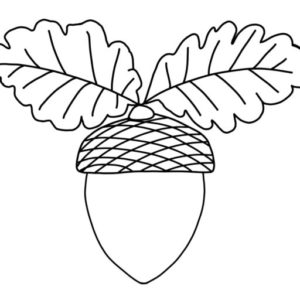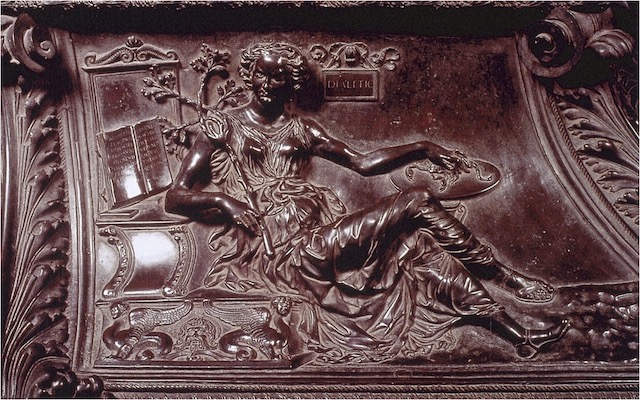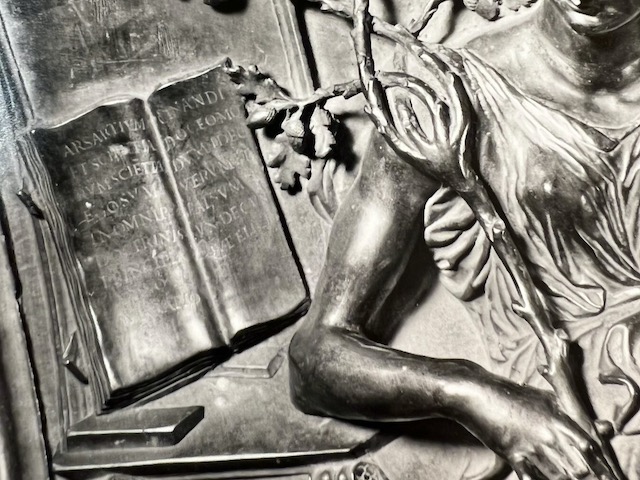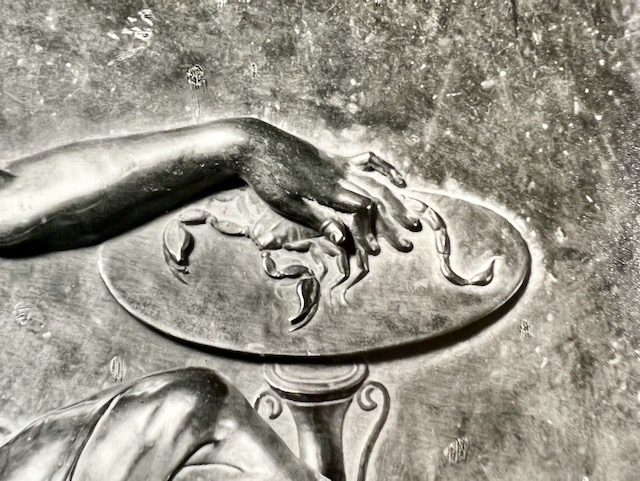Dialectic
To conclude the disciplines in the Trivium, to the left upward side of both Grammar and Rhetoric, is the figure of Dialectica (figure 23). She is shown with a more frontal profile in comparison to the other two figures. Her elbow rests against an ornate lectern with two quasi- serpentine, winged and headed figures that serve as the feet to the lectern upon which an open book rests. The book has the inscription “I am the Art of Arts and the Science of Sciences. I lay down the principles of all knowledge because I teach the method of argument. Therefore, I draw out the true and the false.”[75] (Figure 24) Ettlinger argued that this inscription drew upon several sources: the beginning is a combination of Vincent of Beauvais’s Speculum Doctrinale (III, 4) which stems from St. Augustine’s earlier writings in De Ordine (II, 13) as well as St. Thomas’s Fallaciae and Sumulae which relates more to the later sentences of the inscription.[76]
The figure of Dialectica holds in her right hand the della Rovere oak branch and in her left, holds a scorpion on the table (Figure 25). Instead of emulating Capella’s text, with a snake, the scorpion comes from Alain de Lille’s Anticlaudian. “Her right hand is endued with the charm of flowers; a scorpion, burning upon her left, menaces with a sword-sharp tail.”[77] Pollaiuolo adapted the de Lille imagery, including the scorpion, but replaced the flowers with the della Rovere oak branch. Capella described Dialectic with her “hair beautifully curled and bound together” with a dress from Athens; she held in her left hand a snake, and in her right, a wax tablet with different patterns on them as well as a concealed hook under her robes.[78] From Capella’s description of Dialectic, Pollaiuolo emulated the detail of her hair curled and bound, which he employed for other disciplines as well. Although the texts of Porphyrius, Aristotle, Zeno, and Severinus were included in Alain de Lille’s Anticlaudian, no such references were included within this image either visually or through the inscription. The figure of Dialectic emerged as an invention from Alain de Lille, with some elements from Martianus Capella’s writings, as well as Vincent de Beauvais and St. Augustine, via the inscription. This convergence of multiple textual sources shows how Pollaiuolo adapted these into his unique depiction of Dialectic and the Arts of the Trivium. The combination of texts emphasized the overall resurgence of the Liberal Arts under Sixtus IV, uniting multiple scholars, disciplines, and time periods into the Humanist scholarship of each discipline.
Figure 23. Antonio Pollaiuolo, Tomb of Sixtus IV, Detail of Dialectic, c.1484-1493
Figures 24 and 25. Antonio Pollaiuolo, Tomb of Sixtus IV, Detail of Dialectic Inscription and Scorpion, c.1484-1493



